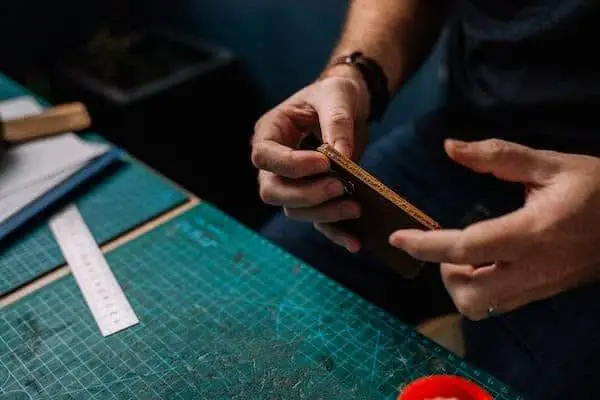It might first seem stressful if your project calls for you to attach the rubber to wood, such as in the case of making stamps.
Whereas many adhesives are effective on wood, finding a product to work on rubber will give you a hard time.
So how to glue rubber to wood? Today, we will help you solve this problem by giving a complete guide. Let’s check it out!
Things You’ll Need
You must use the right kind of glue to adhere rubber to wood so that it doesn’t tear off. We highly recommend rubber glue, contact cement, polyurethane glue, and super glue for this task.
Rubber glue
Rubber glue, as its name implies, aims to work to stick rubber to other surfaces, like wood. This glue successfully creates a solid connection between the two components and is durable enough to withstand frequent use.
Rubber glue is suitable for scenarios where the glued materials will be subject to low or high temperatures since they can endure severe heat.
Contact cement
When you push two surfaces together, contact cement, a two-part adhesive, creates a permanent bond between them.
Make sure to align the surfaces properly before applying the pressure. You can also activate the bond with some heat.
It’s crucial to carefully obey the manufacturer’s directions while working with contact cement.
Generally, you need a thin layer of contact cement for both wood and rubber to bond them. Then, hold them until the glue becomes firm.
Polyurethane glue
Polyurethane glue serves as a two-part glue containing a hardener and a resin. It instantly hardens to provide a strong, watertight bond.
Because the glue is flexible and will change size as the rubber ages, you will find it perfect for attaching rubber to wood.
Super glue
Super glue is excellent for handling wood or other materials. The glue does not need to be clamped to set; it hardens in a matter of seconds.
As the glue dries clearly and rapidly, this choice works best for seamless jobs.
It offers an exact application, so you will only apply it where needed without messing.

Step-By-Step Instructions: How to Glue Rubber to Wood
Once you have selected the right glue for the project, the whole process will go smoothly. Follow these three simple steps to pull it off.
Step 1: Preparation
Surface preparation is crucial to guarantee optimal adherence. Before applying the glue, you must prepare the rubber and wood surfaces properly.
For rubber
Start by using a volatile solvent like acetone to sanitize the surface to eliminate any dirt, oil, tar, grease, or other loose particles.
Next, clean the rubber’s surface of any plasticizers. After this step, exposed rubber will still be, which assures good adhesion.
Finally, give the surface a chemical treatment as you need to activate it chemically and physically.
The best chemicals for this task are alkalis and acids, like hydrochloric acid, sulfuric acid, or trichloroethylene solvent.
For wood
Sealing and leveling are crucial wood preparation steps. You should level it to make it smoother so that it adheres nicely when the glue comes into play without missing any part.
Porous wood needs sealing to stop it from soaking up the glue. You can choose from different sealants, such as silicone sealant or sanding sealer.

Step 2: Application
After the preparation step is done, use a brush to apply the glue evenly on the rubber first and then the wood. Then, stick the surfaces together.
A needle tip can also help when applying blue to wood and rubber. Finally, stick the objects together.

Step 3: Curing
Use tape or a clamp to keep the rubber and wood firmly fastened to one another for good bonding. Then, wait for the glue to harden to remove the tape.
Depending on the glue, drying times might range from a few seconds to hours.
You can also use activators, like the tap or clamp, to help speed up the drying process for adhesives that take a while to cure.

FAQs
1. How can I remove rubber glue from wood?
You need a solvent to remove the glue from the wooden surface. We suggest acetone for this project. Here is what you should do:
Soften the glue with boiling water or a heat gun.
Wet a cloth in acetone and use it to wipe the paste away.
Clean the treated area with a damp cloth.
2. Can Gorilla glue stick to rubber?
Yes. Gorilla glue contains polycyanoacrylate, a sort of cyanoacrylate adhesive. It will be an excellent choice for bonding rubber to wood.
This glue is fast-acting and robust. It performs a good job when creating a firm joint between surfaces. Hence, you can use it for various materials.
3. Can I use liquid nails on rubber and wood?
No. First, liquid nails don’t adhere properly to the surfaces. Moreover, they may damage rubber materials.
4. Is polyurethane glue good for rubber?
Yes. Regardless of how porous a substance is, polyurethane glues will adhere to it. The list of compatible materials includes wood, metals, rubbers, leather, cured epoxy, tile, glass, plastic, concrete, and brick.
5. How to glue rubber foam to wood?
Contact glue works best for attaching foam rubber to wood.
You need to coat both surfaces and press them firmly together. The adhesive can create a permanent bond between them.
Conclusion
You can glue rubber to wood using the right type of glue. We advise using rubber glue, contact cement, polyurethane glue, and super glue to get the best result.
Hopefully, you will find this article helpful. If you have any questions, please feel free to ask. Thank you for reading!
